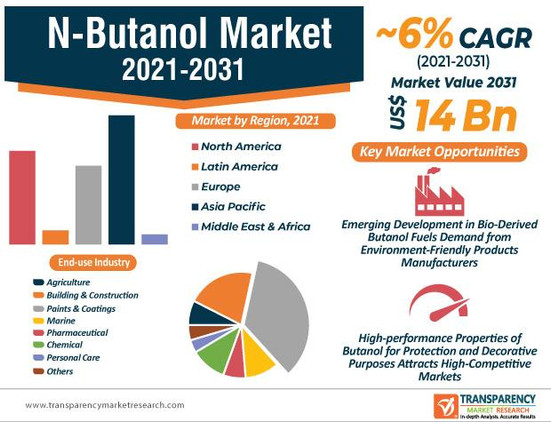N-butanol is a primary alcohol and a colorless liquid of medium volatility. It is popularly used as a chemical intermediate to create other chemicals such as esters and amino resins. It is currently trending in consumer products, and it is used as a solvent for paints, coatings, varnishes, fats, oils, waxes, rubber, and plasticizers. In the manufacturing industry, N-butanol is used in plastics, polymers, lubricants, brake fluids, and synthetic rubber. It is also used as a source of fuel. Over the years, N-butanol has increased its use in the food & beverage industry as an artificial food flavoring. The growing use of N-butanol in several end-use applications is driving the global N-butanol market during the forecast period.
Request A Sample- https://www.transparencymarketresearch.com/sample/sample.php?flag=S&rep_id=54084
N-butyl acrylate and methacrylate are majorly used for latex paints, textile applications, and impact modifiers for rigid polyvinyl chloride. These compounds are the largest commercial derivatives of N-butanol. Moreover, the largest derivatives of N-butyl, butyl glycol ethers are mostly used in solvent applications. Furthermore, N-butanol acts synergistically with butyl acetate as a potential solvent system for nitrocellulose lacquers and thinners to give a solvent system more effective than either solvent alone. Additionally, the solvent from N-butyl alcohol is significantly used in the formulation of pharmaceuticals, waxes, and resins. Other commercial applications on N-butanol include plasticizer esters, butylated melamine-formaldehyde resins, and mono-, di-, and tributylamine. The growing use of multiple applications of N-butanol is driving the global N-butanol market during the forecast period.

Request Report Methodology:https://www.transparencymarketresearch.com/sample/sample.php?flag=RRM&rep_id=54084
The COVID-19 pandemic has severely impacted several end-use industries of N-butanol, including refineries, power generation, chemical processing, food and pharmaceuticals, and others. Regulations against logistics, supply chain, and construction led to the inadequate workforce, limited availability of components, demand drop, low company liquidity, and shutdown of manufacturing. Raw material suppliers and other affiliated businesses were forced to re-evaluate their plans to provide to this industry during this pandemic. The demand from residential and commercial construction witnessed a downfall, while delays in order shipments, supply chain restriction, manpower & equipment shortage, and material shortage were among the common challenges. However, with the pandemic nearing its end, the production capacity is expected to increase in various sectors to overcome the loss. This is most likely to enhance the demand for the global N-butanol market during the forecast period.
Post-COVID-19 pandemic, even after the lifting of trade regulations, it will be challenging for N-butanol producers to rebuild regular functioning conditions. However, with the restoration of the market, several end-use industries are likely to speed up their production to fill the market gap. Several projects were put on halt during the lockdown. Restoring these projects is most likely to create new opportunities for the N-butanol market. Moreover, with rising demand from these industries, the demand for the N-butanol market is expected to grow in the upcoming future. Furthermore, several governments are supporting businesses that had a hard time in the pandemic. Growing investments in these sectors are anticipating N-butanol market growth in the upcoming future.
Request Customization:https://www.transparencymarketresearch.com/sample/sample.php?flag=CR&rep_id=54084
Presently, there is an ongoing market trend for green, sustainable, and non-polluting fuels. Bio-butanol fuel obtained from biomass feedstock generated using the ABE fermentation turns out to be a remarkably clean and sustainable fuel with a comparable high energy density to gasoline. It is a significant replacement for bioethanol fuel, since bioethanol has a lower energy density and is potentially dangerous to the existing internal combustion engines in gasoline. Technological developments and research advancements through CRISPR and bio-engineering, large-scale processing of bio-butanol using fermentation are likely to be possible in the near future. Additionally, the use of N-butanol in genetically modifying certain species of bacteria will help in the increased production with tremendous scope in the energy and fuel sectors.
On the contrary, the mass production of the N-butanol fuel through the traditional ABE fermentation process is still not sustainable due to its toxicity for the bacteria that assist in the fermentation. As a result, most of the N-butanol used in several industrial and chemical applications is synthetically manufactured from the derived crude oil, propylene. As crude oil is a volatile raw material with regular price variations, it eventually reflects in N-butanol’s end products. In 2019
, the building & construction segment dominated the N-butanol market. These segments are most likely to continue their hold on market shares in the near future. Various major market providers are focusing on various organic and inorganic growth strategies such as mergers & acquisitions, new product launches, strategic collaborations, expansions, and joint ventures to improve their product portfolio and business operations. It is likely to create new and better opportunities for the expansion of the N-butanol market across the world.
Pre Book our Premium Research Report@https://www.transparencymarketresearch.com/checkout.php?rep_id=54084<ype=S
In previous years, North America, Europe, and Asia are the leading regions in terms of increasing consumption and demand. However, compared to the other two, North America has witnessed a sharp growth in the following years. However, the Asia Pacific has been witnessed an increased demand for paints & coatings, adhesives & sealants, plastic additives, and various other products, which is likely to boost the regional demand for N-butanol. In addition, North America is also expected to be a highly productive region of the global N-butanol market. The market in the region is expected to expand at a CAGR of ~6%
during the forecast period, due to high demand for N-butanol in automotive, paints & coatings, adhesives & sealants, and plastic additives industries in the region.